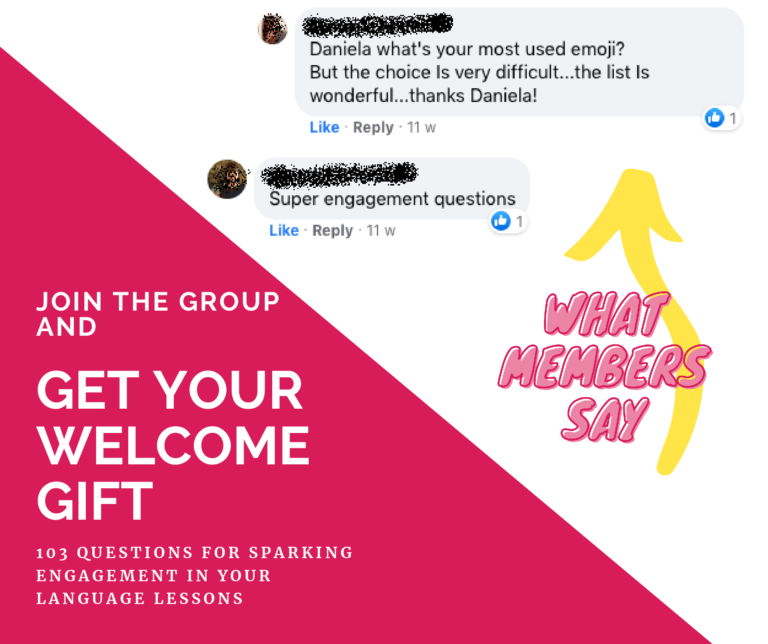
All language teachers have found themselves dealing with challenging behaviour by their students. It’s one of those situations where no matter how clear our instructions and explanations are, the students seem to reject what we say. Where does all that reluctance come from? A sneaky doubt begins to become more and more concrete. You suddenly realise the issue is in the relationship between you and your students. They are not questioning the content of your lessons. In fact, they are questioning you. What to do, then? In this article you are going to learn about what challenging behaviour is, how you can recognise it and, more importantly, how you can address it. I want to walk you through the strategies for dealing with challenging behaviour in the classroom.
The hot questions I’m going to answer in this article are:
- What is challenging behaviour? What are objections?
- How can you be sure you’re dealing with objections?
- How can you overcome objections?
To make it easier for you to implement the tips explained in this post, I prepared a smart troubleshooting guide. You can get it here below: strategies for dealing with challenging behaviour in the classroom Pdf ☟
What is challenging behaviour? What are objections?
Objections are questions students ask or comments they make, which apparently seem to be about the content of your teachings. However they actually question the relationship with you, as a teacher. Objections bring out students’ doubts and fears. They reflect a lack in trust in you or in your method.
In most cases, that lack in trust in you is actually the other side of a lack in trust in the students’ own skills.
What strategies for dealing with challenging behaviour in the classroom can you implement for responding to objections? First of all, you need to be able to recognise the objections and to distinguish between content questions and comments and challenging behaviour.
Content questions or comments
Students come forward with questions and comments about the content of your lesson when they genuinely need to find out more about the insight you gave them, or to get clear on the new input. For instance:
- “I’m not sure I understood this.”
- “Could you please explain this again?”
- “I found this difficult to understand: can you please repeat the whole thing?”
What you understand is that they need help and, more importantly, they are open to receiving help. Once you give them the clarifications they need, the job is done.
Objections
On the contrary, when students come forward with objections, they don’t really mean to ask for clarifications. In fact, what they mean is actually to attack you as a teacher, as a person. The challenge is on the relationship level.
Some examples for objections:
- I don’t want to join in the exercise.
- This was so frustrating!
- This is not what I’d be supposed to learn.
- I don’t see how this can help me to improve my language skills.
Sometimes students object by doing apparently nothing: they don’t want to take part in the activities you propose or they join in, but without showing much effort or interest.
How can you be sure you’re dealing with objections?
Try to give the students clarifications, pour all your heart in going through the new input again and again, and what you will get is CRICKETS. Yep. Because the trouble here is not they didn’t understand what you’re trying to teach them. The problem is that they are saying: “I don’t want to do this”, “I don’t want you as a teacher”, “I don’t trust your method.”
How can you overcome objections?
Now, there are hundreds of reasons why students bring out objections. Usually, the root is in fear. Fear of stepping out of their comfort zone and of doing something in which they may be not successful, fear of feeling ridiculous in front of the others, fear of not achieving the expected results, fear of not being able to do it.
The good news is that you don’t need to dig into the reasons why your students bring out objections. You don’t even need to understand what type space those objections come from. Nevertheless, what’s really important you add to your toolbox is the ability to address those objections.
Here comes the collection of strategies for dealing with challenging behaviour in the classroom I crated for YOU. I have collected the most frequent objections I received during my courses or during other teachers’ courses. I put them together in a Troubleshooting Guide for the language teacher and I designed a troubleshooting process you can implement starting from today: strategies for dealing with challenging behaviour in the classroom Pdf ☟
The troubleshooting guide proposes a very simple way to implement the strategies for dealing with challenging behaviour in the classroom: in fact, it consists of only 2 strategies:
- embracing
- addressing.
By embracing I mean pacing. In other words, you want to let your students know you see their point and you understand. The goal is to create a bridge between you and them.
By addressing I mean you show them you want to do something about the matter they’re raising. And, what’s more important, you’ve got a plan!
The guide provides you with more details about the strategies for dealing with challenging behaviour in the classroom. I structured the guide as follows:
- What students say (how they phrase their objections)
- What students really mean (on a deeper level, what their objections mean)
- How to address those objections (what to say to embrace the objections and what to say to address them in order to move forward).
Furthermore, the guide includes examples, as well, so that it’s easier for you to take inspiration from the examples and to implement the strategies for dealing with challenging behaviour in the classroom. Strategies for dealing with challenging behaviour in the classroom Pdf ☟
Wrapping up
Firstly, it’s important you become confident in distinguishing content questions and objections. Remember, objections lay on the level of relationship. Secondly, follow the troubleshooting guide for sorting the objections out and for inviting the students to move forward.
Bear in mind: you can’t please all of your students, maybe some of them will keep on disliking you. But you can certainly gain their trust and take them all to the achievements you want to get them to. There’s a key. In the Guide you’ll find out about how to get that key. Good luck!
Want more support?
Join the Facebook group Independent Language Teachers Collective to get daily advice, tons of free training and to branch out with other independent language teachers like you!
ALSO…
Available only for the Collective members: free list 103 question for sparking engagement in your language lessons.
This is what members say about the freebie:

Join in the Collective and grab your welcome gift:


